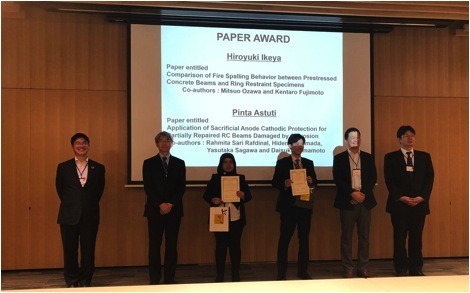Indonesia frequently builds infrastructures adjacent to sea waters due to its position as an archipelagic state. Bridges or overpasses, piers, embankments or dikes, and resorts in coastal areas are infrastructures regularly exposed to marine environment, leading to a chlorine-induced corrosion. Marine environment, especially sea waters, becomes a major element that causes corrosion so that the infrastructures require adequate management and anticipation.
A lecturer of Department of Civil Engineering of Universitas Muhammadiyah Yogyakarta (UMY), Pinta Astutui, S.T., M.Eng. contributed an electrochemical repair technique, known as sacrificial anode cathodic protection to overcome the chlorine-induced corrosion. Pita stated that the invention mainly examines repair techniques in building structures. “Many structures in Indonesia bear damages because of intrusion of sea waters into a concrete structure that accelerates corrosion in the concrete reinforcement. If corrosion ensues, the volume of concrete reinforcement will bloat, causing an internal pressure on the concrete that forces it to crack and spall. As a result, the corrosion of reinforcement adversely affects the safety and the serviceability of concrete structures, and then shortens the service life,” declared Pita in an interview on Monday (20/6) at Office of Public Relations and Protocol, Universitas Muhammadiyah Yogyakarta.
Sacrificial anode cathodic protection can ameliorate corroded structures. Besides, the technique can also limit the extent of concrete replacement and extend the service of life patch repairs to corrosion damaged reinforced concrete (RC) structures. “Sacrificial anode cathodic protection flows current−utilizing electron conductor metal as zinc−to steel reinforcement inside the concrete. As the current flows, the zinc is eventually ‘sacrificed’ because the electrons devolve to the steel reinforcement. Thereafter, the corroded steel reinforcement will receive electron supply from the zinc to stop the process of corrosion. Based on a preliminary research, the technique demonstrates an effective process to establish structures in buildings,” conveyed Pinta.
Furthermore, Pinta explained that Indonesia now has started to implement sacrificial anode cathodic protection on bridges and piers exposed to seas. However, the implementation has yet been effective due to inappropriate methods and non-optimal monitoring processes. “Hopefully, researchers and industries in Indonesia will soon make collaboration to advance the implementation of this technology,” confessed Pinta.
Additionally, Pinta has been awarded the International Academic Awards for her presentation at the 4th International Symposium on Concrete and Structures 2019 (CSN2019) in Hokuriku District, Prefecture Kanazawa, Japan. Pinta also obtained a nomination for the Paper Award after presenting her research entitled “Application of Sacrificial Anode Cathodic Protection for Partially Repaired RC Beams Damaged by Corrosion”. In 2018, Pinta acquired the Best Presentation Award in a similar event in Bangkok, Thailand.
Moreover, Pinta had to compete with 130 participants from fifteen countries for the international recognition. The event eventually aimed to build an international research network and as a means of exchanging ideas related to the material research and concrete structures so that there will be an alignment among industries, governments, and academicians to develop sophisticated concrete structure technologies. Indeed, the symposium was addressed to enhance competence and knowledge of young engineers so that they can contrive excellent research. Furthermore, Pinta revealed that the research was collaboration between Mitsubishi Construction Co. Ltd and a researcher specialized in cathodic protection for concrete structures and an alumna of Kyushu University, Dr. Eng. Rahmita Sari Rafdinal.







